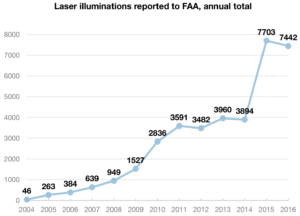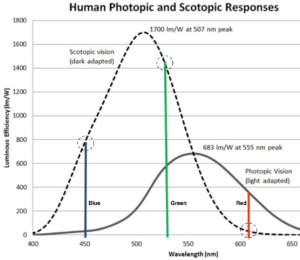By Patrick Murphy
In October 2016, the U.S. Food and Drug Administration (FDA) put forth a preliminary proposal to declare green, blue, yellow and violet laser pointers as “defective.” Only orange-red and red laser pointers would be allowed to be manufactured, imported or sold in the U.S.
This proposal was in response to the thousands of illegal and unsafe laser pointers aimed at aircraft in the U.S. According to the Federal Aviation Administration (FAA), pilots reported 7,442 laser incidents in 2016 — more than 20 every night. 91% of the incidents involved green laser light.

Laser Illuminations reported to U.S. FAA, annual total
Safety experts are most concerned about the bright light from laser pointers causing distraction, glare and temporary flash blindness. When visual interference occurs during critical phases of flight such as takeoffs, landings, low altitude maneuvers and emergencies, there is potential for an aircraft accident. Visual interference also has disrupted police and rescue missions.
Pilot groups and lawmakers have called for restrictions on pointers, especially green ones. For example, in February 2016 Sen. Chuck Schumer (D-N.Y.) met with the incoming FDA commissioner, who agreed to consider having FDA ban the sale of green pointers.
To understand FDA’s proposal, it is helpful to describe how FDA can change its regulations, and what a finding of “defective” means.
Under 21 CFR 1040.10 and 1040.11, FDA has limited regulatory authority over laser devices, and over three laser uses. These regulations were written well before laser pointers and thus do not specifically address pointer usage or misuse. (A separate law passed by Congress in 2012 as part of FAA legislation does make it illegal to aim the beam of a laser pointer at an aircraft, or the flight path of an aircraft. The penalty is up to 5 years in prison and/or up to a $250,000 fine.)
To update its regulations, FDA is required to present them first to a permanent statutory committee, the 15-member Technical Electronic Product Radiation Safety Standards Committee. In October 2016 FDA presented TEPRSSC with a wide range of electronic product radiation safety proposals. Two of these dealt with laser pointers.
The first proposal was to define “laser pointer.” The agency suggested the following wording:
Handheld laser products designed for battery-powered operation that are manufactured, designed, intended or promoted to provide illumination, designation of a target or point of origin, or sighting, with no associated technological or scientific purpose for the laser’s emission. Laser products are not excluded as laser pointers when used for visual entertainment, vision disruption, to startle, or novelty purposes.
The second proposal was to restrict laser pointers based on the beam color.
The FDA showed TEPRSSC members the following chart showing the eye’s sensitivity to colors under light-adapted and dark-adapted vision:

Human photopic and scotopic response
The three circled areas show how the dark-adapted human eye (dashed curve) perceives red light as much dimmer than equivalent amounts of blue and green light.
FDA told TEPRSSC that “[t]he hazard from laser aircraft illuminations would be effectively eliminated if green and blue laser pointers were not available. Colors at 615 nm and longer, viewed with night-adapted vision, appear only 1.4% as bright as green at the commonly manufactured 532 [nm].”
FDA then invoked 21 CFR 1003.2. This regulation states that a product is defective if it “… emits electronic product radiation [in this case, visible light] unnecessary to the accomplishment of its primary purpose which creates a risk of injury …”
FDA said there is a risk of injury from visual impairment from laser pointers aimed towards operators of aircraft, vehicles and watercraft, and noted that “pilots are particularly vulnerable to disruptive visual impairment at night.” Based on this risk, FDA would prohibit the manufacture or importation of laser pointers from 400 nm (deep violet) to 609 nm (red-orange). Pointers from 610 nm to 710 nm (deep red) would be permitted.
As with current laser pointers, the power output would be limited to less than 5 milliwatts.
If implemented, FDA’s proposal would not affect individual possession of laser pointers in the 400-609 nm range. It would only restrict manufacture and importation of such pointers.
A key benefit of FDA’s proposal is to make it easier to control the vast majority of pointers — green — that are involved in pilot reports of laser interference. If a pointer’s beam is any color other than red or red-orange, it would not be permitted for sale in the U.S. No additional testing, using expensive power meters, would be necessary.
In addition, state and local authorities could enact color-based restrictions based on FDA’s “defective” determination. This would, for example, allow a police officer to take action such as confiscation based solely on the color of the laser beam. FDA told TERPSSC ” we envision that just like any other hazardous product that has been determined to be defective, that state and local … ordinances and laws would be put in place that would likely deal with the use of green and blue laser pointers.”
Members of the TEPRSSC committee generally agreed with FDA’s laser pointer proposals, while also raising some concerns for further consideration.
The next step is for FDA to review its TEPRSSC proposals in light of the members’ comments, and make any changes FDA feels are appropriate. After this, FDA would publish the official proposed regulations in the Federal Register. The public would have from 30 to 180 days to comment. Based on those comments FDA could drop a proposed rule, change it and resubmit for new comments, or proceed with a final rule if comments were favorable or only required minor changes.
In summary, the FDA has made a first-in-the-world proposal to allow manufacture only of red pointers (610-710 nm). By designating all others (400-609 nm) as “defective”, this would give the agency additional regulatory authority which makes it much easier for authorities to determine which laser pointers may be imported, manufactured or (depending on state and local laws) sold, owned or used.
Additional details about the proposal are in an 11-page paper presented March 21 at the International Laser Safety Conference, available online at http://bit.ly/2pvfwpw.





